Who will wash your clothes and iron your formals and whites if not these Dhobis? Almost hidden and unnoticed by people, Mysuru has four Dhobi Ghats where families of washer men try to sustain themselves by washing and ironing clothes from dawn to dusk. One can always find them scrubbing and washing clothes and later running around to deliver their clothes on time. Though the clothes that are up for drying presents a Clean Picture, their lives are hard and their workplace presents a Dirty Picture. They work hard in a 12-hour-a-day profession and suffer many health problems as discussed in this Weekend Star Supplement. Perhaps the solution is in betterment of their conditions.
Lives squeezed out dry
By B.C. Thimmaiah

Rows of freshly-cleaned clothes hanging on the poles to dry in hot sun, gently swayed by moving winds, a steady rhythmic slapping sound, symmetric brushing and arranging clean clothes to be dried in the next row, steady supply of dirty clothes to be washed on the washing stones placed at the back or on the sides…
Sounds fascinating, doesn’t it? — No, not entirely. Life at a Dhobi Ghat is hardly as clean and enticing as it looks. Mysuru has four Dhobi Ghats — Kukkarahalli Lake, Yadavagiri, Gobblikatte below Chamundi Hill and Kesare — and one visit here gives a picture of the struggles faced by the men and women who keep our clothes clean, ironed and ready-to-be worn everyday.
Their hard labour, most of the times, do not come to the fore and remains in obscurity unless one wants to dig deep into their. LIVES THAT ARE SQUEEZED OUT DRY.
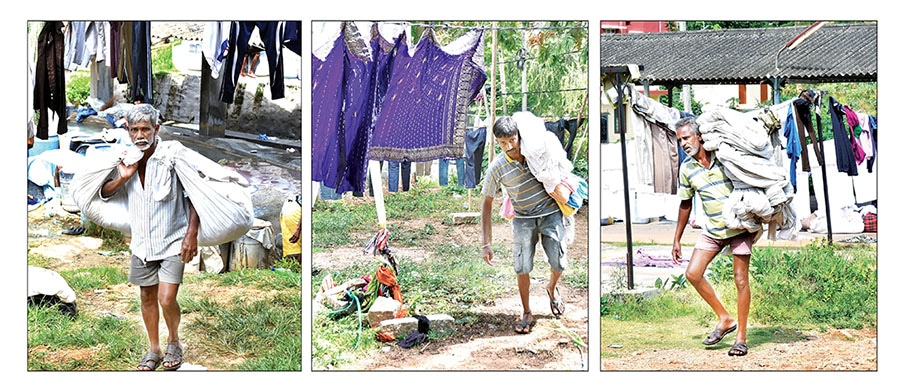
They stand inside sudsy water at Dhobi Ghats to beat odds
Rising at 4 am every day, picking up a pile of dirty clothes from hotels, homes, villas and sometimes hospitals, these Dhobis soak the clothes in water and then beat the same on stones at the Dhobi Ghat. They rinse the clothes and squeeze them, laying out to dry — all under searing heat in an open air area, which is necessary to keep clothes clean and the area less damp.
The actual washing begins at 6 am and goes on till 3 pm after which the dirty linens are neatly pressed and packed to be delivered back to the customer’s place. Each Dhobi ends up washing over a 100 clothes a day. And combined, all Dhobi Ghats churn out more than 10,000 washed and pressed clothes every day.
A Dhobi is a laundryman who collects dirty linens and returns them washed and neatly pressed from open-air Laundromats, or ghats. Clothes are washed in individual, open-air concrete wash pens, each fitted with a flogging stone. The word ‘Dhobi’ has been derived from the Hindi word ‘dhona’ and the Sanskrit word ‘dhav’ which literally means to wash.
Clothes are soaked in sudsy water and then the dhobis thrash the garment repeatedly on the stone — relentlessly pounding the dirt from the clothing. Dhobis spend most of their day knee-deep in stagnant pools of murky water.
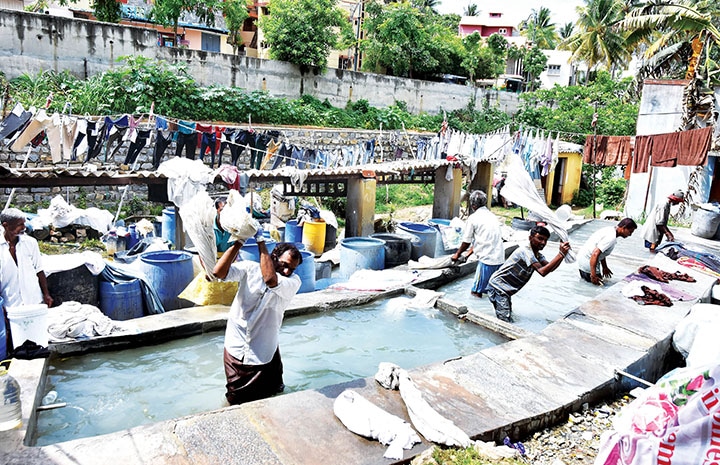
The garments are then scrubbed, hung out to dry, ironed, neatly folded, then returned to the customer. Because the clothes are marked from the outset with a code (usually on the inside of the garment), the clean clothes are returned to the proper owner. In many cases, the laundry work has been handed down from generation to generation.
Standing constantly inside sudsy or soap-and-chemical-foam-filled water has led to the rise of various ailments. After the day’s wash, legs get bloated and are whitish in colour. The cracked soles of the feet make matters worse and Dhobis are prone to infections.
Fifty-year-old Ravi, one of the washer men at Kukkarahalli Lake Dhobi Ghat was unable to walk steadily as both of his legs are infected. He is under treatment and it costs Rs. 3,500 per session with doctor including medicine charges. “I cannot rest despite my condition as I have to feed my family. I still stand inside chemical-filled water from 6 am to 1 pm and when I get out, there is unbearable itching. I have to apply cream that costs Rs. 300 for a small tube. I was out of work for more than 6 months and had to spend more than Rs. 30,000 for the treatment,” he says.
After his wash job, Ravi stretches his legs under the sun for some relief. “If I don’t do this, my legs get infected and resting under sun gives me some relief,” he says.
From pile to line — A story of hard labour
A crucial factor in sustaining a Dhobi family is the unity and co-operation between the family members to finish a day’s work. While one person washes clothes, another hangs them to dry while others bring water, or collect/distribute clothes. Usually, the men wash clothes while women and grown-up children hang the clothes and keep a watch. If it rains, they have to scramble to take off the clothes from the poles and railings.
Hanging clothes on the poles too is an art and once the clothes are somewhat ‘joined’ to the thread, the poles are lifted straight and planted on the ground. It stands in a balance and withstands the wind and weight of the clothes. A windy and sunny atmosphere dries the washed clothes fast. Once dried, the clothes are removed from the poles easily and neatly packed. Each Dhobi family has its own regular customers and designated areas from where they collect clothes. They identify their set of clothes with initials, or other markings. They claim decades of relationships with their loyal customers.

Getting clothes form the pile to line takes a lot of work. Clothes that have stubborn stains are soaked in soda and soap-oil water the previous night. The next morning, they are brushed, rinsed and beaten on stones to remove stains, especially in white robes and sheets.
Handi Halla Dhobi Ghat
The Dhobi Ghat at the posh locality of Yadavagiri is called the Handi Halla Dhobi Ghat. This place is contrastingly opposite to the name and fame of Yadavagiri where some of the wealthy people live.
Located by the side of a huge storm water drain, the Handi Halla Dhobi Ghat paints a sorry picture. Though some concrete structures are built for the shelter and convenience of the Dhobis, the place is in a mess. Water from the open drain leaks into the Dhobi Ghat right where the washer men clean clothes and sometimes the drain stinks.
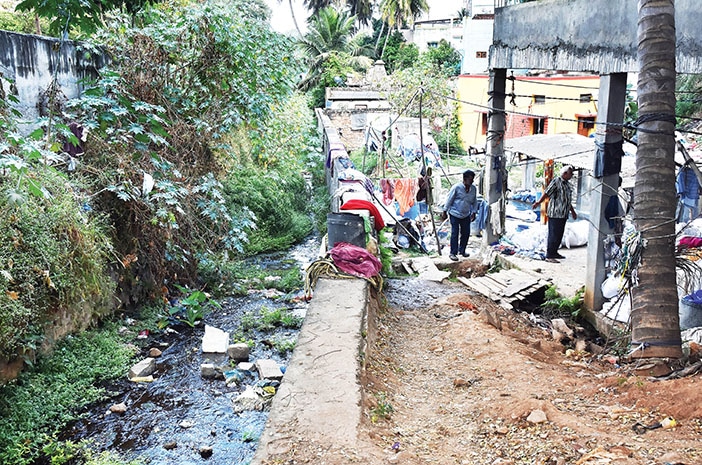
While many Dhobi Ghats in cities have seen automation in the form of washing and drying machines, these Dhobis have to do everything manually. 50-year-old R.C. Mahesh has been doing this job since the last 18 years. He gets up at 4 am and after a day’s hard work, he goes to bed at 10 pm. “The main issue for us is health. Standing in the middle of soap and chemical water blocks smooth flow of blood to the lower parts of the legs. Also, we have to bear with skin allergies and if we do not take care, the infection will lead to gangrene,” he says.
At the Handi Halla Dhobi Ghat there are over 30 washer men families doing the daily chores. The Dhobis are from Madivala community and they are demanding inclusion in the Scheduled Caste list so they get Government benefits. “We are under the reservation category 2A and it is of no use. We don’t have any medical facility and no means to educate our children so that they can lead a better life. Blood flow was blocked in my legs and I had to spend Rs. 60,000 from my pocket,” he reveals.
Rs. 34 lakh grant for washing, drying machines yet to reach us
This is a lake area that was handed over to the Madivala community by the Maharajas. It is a three-acre area and we have half-built the boundary wall out of MLA and MP funds. When we ask for facilities, MUDA asks us for land records or proof of land ownership. Rs. 34 lakh has been released by the Government to procure washing machine here but MUDA is withholding the money for reasons best known to them. We have the records and Encumbrance Certificate to prove ownership and will fight till we get better facilities,” says Chowdaiah, President of Mysuru City Veera Madivala Mahajana Seva Sangha, Saraswathipuram (Kukkarahalli Dhobi Ghat).
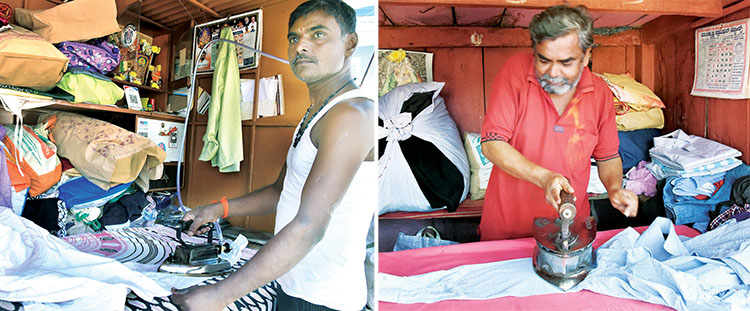
Dhobi Ghat bathroom has no water, power, chamber and so locked 24X7
Organising Secretary of the Mysuru City Veera Madivala Mahajana Seva Sangha, Shivashankar said that there is a need for a Samudaya Bhavan for the community. “Compared to Yadavagiri, Kukkarahalli Dhobi Ghat is neat and spacious. But we need machines as they will reduce manual labour a lot. The bathroom that has constructed for us has no power, water or waste collection/ disposal chamber. So it is permanently locked,” he said.
“This land has been donated by Maharajas and later transferred to MCC and later to MUDA. Now it is under 30-year lease. We need better facilities. One of our fellow washer man recently died of gangrene and his leg was bloated and infected,” he added.
No automation, only hard manual work
In Tamil Nadu, there are washer men society that supplies machines, washing soda, chemicals and loans along with subsidies. Here we don’t have any facilities and our workplace is dirty. Dhobi Ghats in Bengaluru are equipped with washing machines and LPG iron. We still use steam iron here. Though the politicians promise the moon when they come for election, nothing has been done to our benefit.”
“The Mysuru City Corporation (MCC) provides free water and the Handi Halla land was given to Madivala community by the Maharajas. The Mysuru Urban Development Authority (MUDA) has the responsibility of maintaining the Dhobi Ghat and to provide facilities. Here we have nothing but a stinky atmosphere, dilapidated structures and heavy manual work,”
— R.C. Mahesh, Handi Halla Dhobi Ghat
Officials who wax eloquent on Swachh Bharat must come here
Schemes sanctioned under JnNURM project have been left incomplete and many representations have been made to MCC and MUDA. We have strained ourselves by going there 15 to 20 times but nothing has been materialised so far. Our Dhobi Ghat is located in a pit and all the dirt around flows in here along with the dirty water in the adjacent storm water drain. MCC officials who wax eloquent about cleanliness and Swachh Bharat must visit here to know the life we live. It is worse than slums.”
“There are no toilet facilities here and no changing rooms for women. The vast area can beautifully be developed and automation facility can be provided. With machines, we can wash clothes and dry them. All our health problems will be solved.”
— S.N. Mallesh, Handi Halla Dhobi Ghat Association President
Donkey’s milk, the new elixir
Cleopatra VII Philopator, the last ruler of Ptolemaic Kingdom of Egypt, used to bathe in it to preserve her legendary beauty. Even after centuries, donkey milk is still in business as a super food, fetching Rs. 700 for 100 ml.
Cleopatra supposedly took a daily bath in milk supplied by a herd of some 700 lactating donkeys. History says that even Pauline Bonaparte, French military leader Napoleon Bonaparte’s sister and Poppaea Sabina, the second wife of Roman Emperor Nero used donkey’s milk for its beauty-enhancing properties. Donkey milk has therapeutic properties that include anti-ageing and antioxidant qualities. It is also considered very good for infants, especially those with gastric problems, and for people suffering with skin allergies.
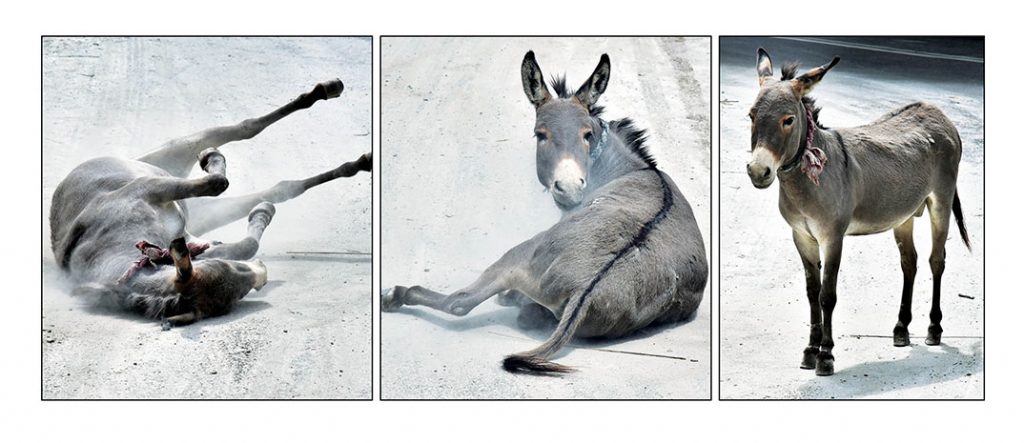
The milk is rich in vitamins and essential fatty acids and has less fat than cow milk. According to UN’s Food and Agriculture Organisation, donkey milk has “particular nutritional benefits”. It’s seen as an alternative for infants affected by cow milk protein allergies. Donkey milk also has a natural anti-inflammatory and antihistamine action which is an excellent cure for skin diseases.
Donkey milk is a good source of income for some of the washer men families and also nomads. “People come to us as early as 7 am with children and feed the kids with donkey milk. Since donkeys don’t yield much milk, people have to wait or come back the next day,” says a Dhobi at Yadavagiri. Some washer men, during their free time, go with lactating donkeys around the city and earn a decent amount of money that supplements their income.
Dhobi Ghat idea was inspired by Hampi Bhojana Shalas
It was TV journalist Sreenivasan Jain’s grandfather M. A. Sreenivasan who had conceptualised the idea of Dhobi Ghat in Mysuru. Sreenivasan was a Minister in the Princely State of Mysore during the reign of Nalwadi Krishnaraja Wadiyar. Even the land for the Dhobi Ghat was sanctioned by him.
The then Mysore Government had initiated several schemes for the benefit of communities be it the low-cost housing initiatives (Agraharas), or the innovative Dhobi Ghat. Sreenivasan’s idea of Dhobi Ghat was borrowed from the Bhojana Shalas of the Hampi ruins.
Several major temples in Hampi have an embedded kitchen and 100 or more pillared feeding halls. Hampi also had a dedicated public Bhojana Shala (house of food) where numerous thali (dish) were carved in series in a rock on both sides of a water channel. One example is found near an octagonal fountain in the south of the Royal Centre. According to Epigraphical sources, this Hampi Bhojana Shala was an ‘ootada kaluve’ or canal connected with eating.
M.A. Sreenivasan started his career as a young Mysore Civil Service officer in 1918. He served both Mysore Kingdom and then the Government of British India. He was made a minister (Pradhan) in 1943. In 1947, he was invited by the Maharaja of Gwalior to become the vice-president (Dewan) of that State.
Journalist Sreenivasan Jain’s mother Devaki Jain is an economist and writer, who has worked mainly in the field of feminist economics. In 2006 she was awarded the Padma Bhushan for her contribution to social justice and the empowerment of women.



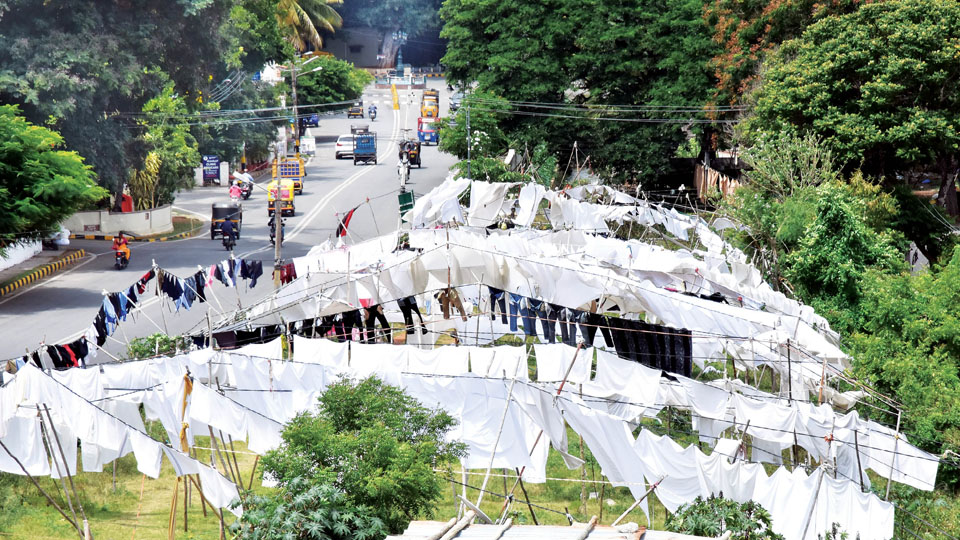




Kudos to a well researched, beautifully illustrated and attractively written article on Mysuru’s dhobi ghats. Being a resident of Yadavagiri, I regularly walked by the dhobi ghat. I always wondered that some one should write an article about the woes of the hard working people who meet the needs of Mysureans. Finally I was happy to read one such article. Congrats to Sri. B C Thimmaiah.
Great article on people who live on the margins to supply an essential service to the rest of us! Yes, remember the dhobies who plied their trade in a ghat near our home in Madras (now Chennai) in the 1960s. A hard life. And remember several of them with their swollen legs,and their visits to my father who was a doctor (and who, like many doctors in those days, would not take any money from them). And their donkeys who used to carry their loads. Remember feeling sorry for these donkeys also and trying to feed them and stroke them, though they could kick if they got irritated or alarmed!
These are the things and people our government should be focussing on, not on grandiose projects or schemes to inflate their ideas of (fake) greatness.
The aside on Srinivasan Jain’s grandfather and mother was interesting.
It is unacceptable in this 21st Century, and in India after it became a republic 7 decades ago, to see these people suffering so much physically to provide a service. It is not as expensive as sending a robot to the Moon, to provide them with large washing machines and water to wash. That should be a priority project too for the central and state governments. After providing the above facility at governments’ expense, Modi and Yedi would eran their selfies with these machines as the background.
Otherwise, it is a slave labour. These people need not have to suffer to eke out a meagre living.
@Govind Pai In Chennai, do they use the heavily -polluted Couum river for washing?
What a culture! Hahaha, yes the famous and odoriferous waterway of Chennai (only the aptly named “Buckingham Canal” of the same city could give it a run for its money!). I am sure it was the stuff from which many a shirt was “washed” though today there is nothing to choose between this and the once pristine waters of the Ganga. And maybe it was here in Robert Clive’s time that Ill gotten gains were first laundered. (Now the laundering is done through “electoral bonds”). The dhobis I knew got their water from the water works in Kilpauk, the excess water released after treating the water from the Red Hills reservoir.